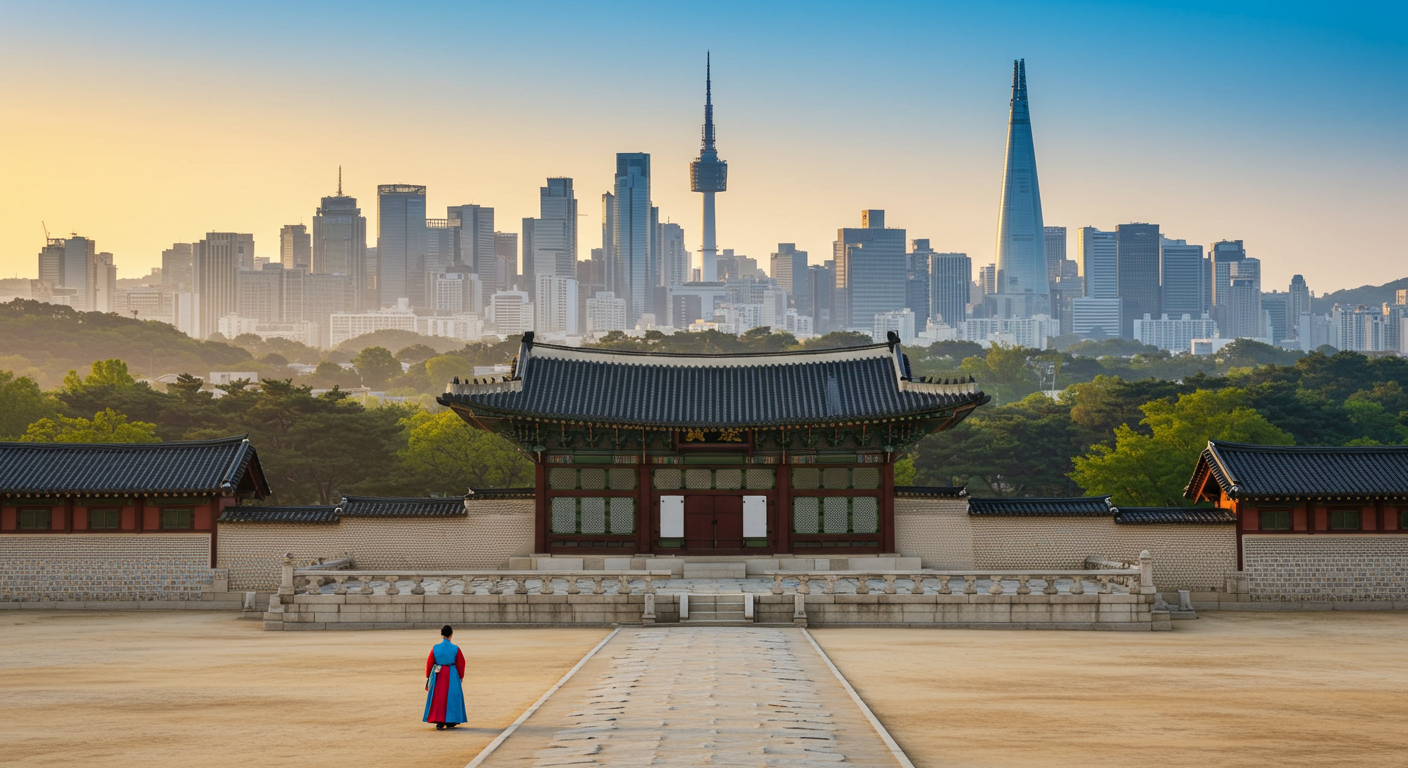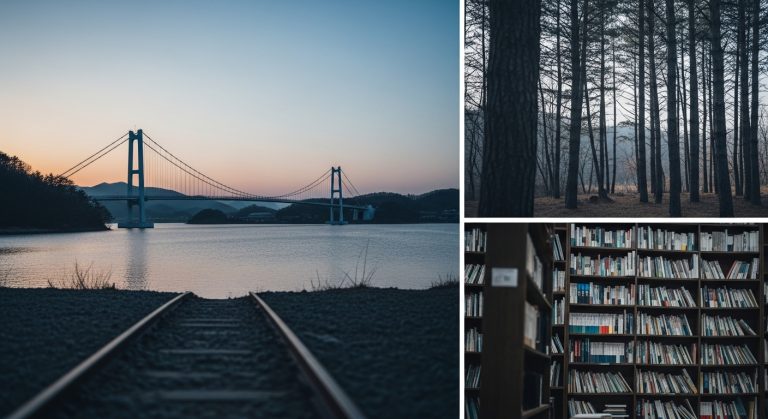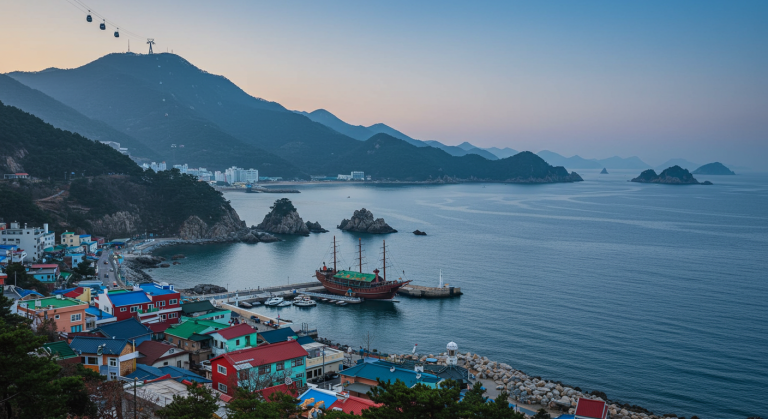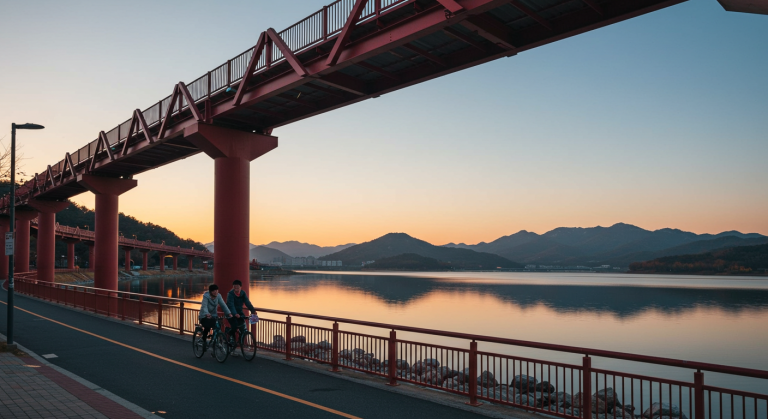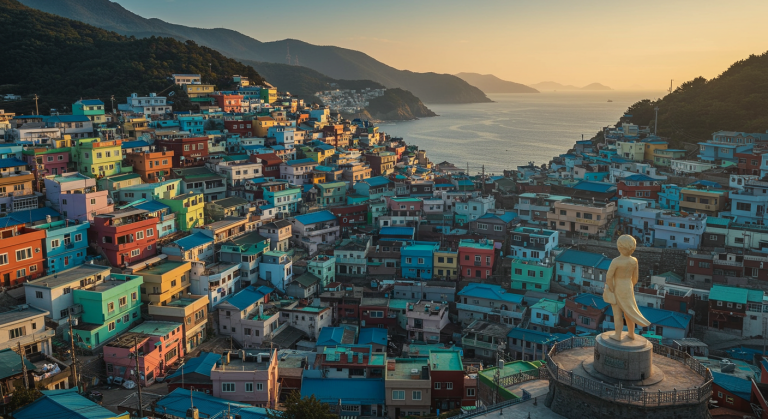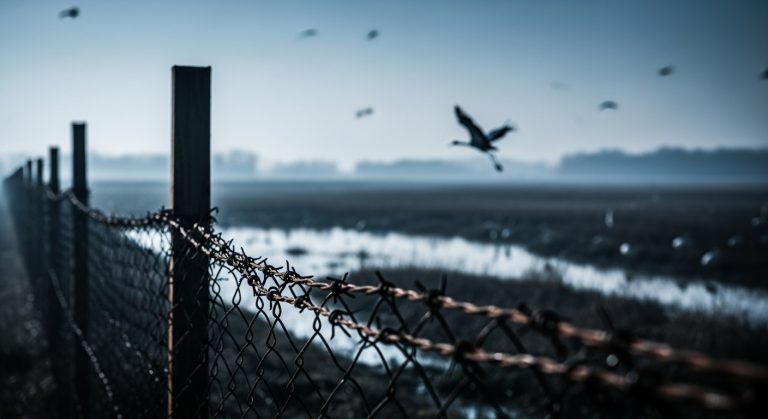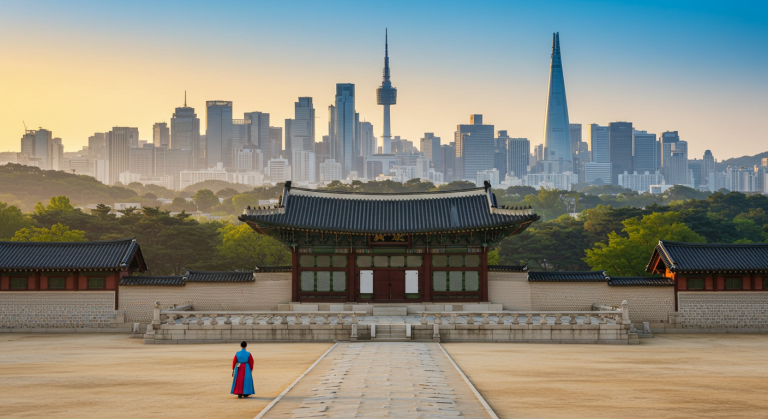Escape to Paradise: Planning Your Unforgettable Trip to Geoje, South Korea’s Coastal Gem

Geoje Island (거제도), South Korea’s second-largest island, is a breathtaking blend of dramatic coastlines, European-style gardens, and deep historical roots.
This comprehensive guide dives deep into the **must-see attractions** like Oedo Botania and Windy Hill, reveals the local secrets of Geoje’s incredible seafood cuisine, and provides the essential logistics to plan your perfect, unforgettable island escape.
Have you ever felt that deep, aching need for an escape, a place where the air smells of salt and pine, and the horizon stretches limitlessly across the sea?
I certainly have, and that feeling is precisely what led me to fall head-over-heels for **Geoje Island**, or Geojedo, off the southern coast of South Korea.
It’s often overshadowed by the more famous Jeju Island, but trust me when I say Geoje offers a unique, rugged, and intensely beautiful charm all its own.
This isn’t just a travel guide; it’s a detailed blueprint forged from my own experiences, helping you navigate everything from scenic coastal drives to the best places to devour local seafood.
So, let’s pack our bags and dive into the tranquil, professional beauty that is Geoje Island! 🌊
The Majestic Trio: Geoje’s Iconic Crown Jewels
When friends ask me where to start in Geoje, I always point them towards the three iconic sights that define the island’s visual identity.
These spots are famous for a reason; they capture the island’s drama, history, and cultivated beauty in one unforgettable sweep.
1. Oedo Botania: The European Garden Paradise
Oedo Botania is, without question, the highlight of a trip to Geoje, transforming a barren rocky island into a breathtaking Mediterranean-style botanical garden.
It’s an incredible story of passion, built painstakingly over decades by a dedicated couple, making it a true testament to human effort and nature’s harmony.
The experience starts with a scenic ferry ride, which usually loops around the spectacular Haegeumgang cliffs before docking at Oedo.
Once you step ashore, you’re transported to another world, complete with impeccably manicured landscapes, stunning sculptures, and panoramic ocean views from the Venus Garden.
Accessing Oedo is only possible via a tour ferry from ports like Jangseungpo or Dojangpo.
During peak season (summer and spring flower bloom), tickets sell out quickly, so it’s essential to book your round-trip ferry ticket and Oedo entrance fee bundle in advance.
Check the ferry operator’s schedule; they strictly adhere to departure and return times, giving you about 90 minutes to explore the island itself.
I remember visiting in the early spring, and the sight of the **camellias** blooming against the deep blue sea was nothing short of cinematic.
It truly feels like stepping onto a private, luxurious estate carved right out of the Aegean Sea, but located firmly in the heart of South Gyeongsang Province.
2. Windy Hill (Baramui Eondeok) and Sinseondae Cliff
The name says it all: **Windy Hill** is a grassy knoll, perpetually swept by a refreshing sea breeze, offering an iconic view that has graced countless Korean dramas and variety shows.
It’s a relatively easy climb, leading you to a picturesque windmill that stands proudly against the backdrop of the cobalt blue ocean and scattered islets.
The views from the top are expansive, allowing you to fully appreciate the rugged beauty of Geoje’s southern coast, a vision of rocky inlets and turquoise water.
Just a short walk away is the **Sinseondae Cliff**, which is often paired with Windy Hill on travel itineraries, providing an even more dramatic photographic opportunity.
Sinseondae is characterized by multicolored, layered rocks that plunge into the sea, a spot that literally means “Place where the Gods and Immortals played,” and the name is perfectly fitting.
The sheer geological beauty here makes you feel incredibly small and connected to the ancient, powerful forces of nature.
3. Haegeumgang Island: The Sea’s Diamond
Often viewed from the Oedo ferry, the magnificent sea-carved rock formations of **Haegeumgang** stand alone as a masterpiece of natural erosion.
This uninhabited island is part of the Hallyeohaesang National Park, and its name translates literally to “Sea Geumgang,” comparing it to the famous Mount Geumgang.
The best way to appreciate Haegeumgang is to take a specific cruise that maneuvers slowly through the famous cross-shaped cave entrance, giving you a thrilling close-up view.
The sheer scale of the columnar basalt and the sound of the waves echoing within the cave are truly awe-inspiring, a visceral reminder of the ocean’s sculpting power.
Diving Deeper: Hidden Gems and Historical Footprints
Geoje isn’t just about its famous landmarks; its heart lies in the smaller, quieter spots and its surprising historical depth.
To truly experience the island’s soul, you need to venture a little off the main road and embrace both the natural and man-made treasures it holds.
Jisimdo: The Island of Camellias
Dubbed “The Island of Camellias” for good reason, Jisimdo is a smaller island sanctuary covered almost entirely in a lush, dense forest of camellia trees.
If you visit between late winter and early spring (February to April), the island floor is often blanketed with brilliant red petals that have fallen from the trees, creating a stunning, carpet-like effect.
Unlike Oedo, which is a cultivated garden, Jisimdo offers a much more wild, natural, and tranquil hiking experience.
It’s a wonderful place to clear your mind, listening to the birds and the gentle sound of the wind moving through the thick evergreen canopy.
Maemiseong: The Modern Fortress
**Maemiseong Castle** is a fascinating example of dedicated folk architecture, a stone fortress built not by ancient kings, but by a modern Geoje resident.
After Typhoon Maemi severely damaged his property, the owner spent years building this sturdy European-style fortress by hand using natural stones to protect his land from future storms.
It stands as a beautiful, slightly whimsical monument to resilience, offering an incredible photo spot with the vast blue ocean stretching out behind its unique ramparts.
The creative ingenuity and sheer effort behind Maemiseong make it a genuinely heartwarming and inspirational stop on your tour.
- Hakdong Mongdol Beach: Known for its black, rounded pebbles (‘Mongdol’).
Instead of sandy silence, you hear the soothing, unique sound of pebbles rolling with the waves (the famous ‘Mongdol-sori’). - Gujora Beach: Features soft, **white sand** and calm, sheltered waters.
Perfect for swimming and relaxing, often considered one of the most classic beautiful beaches on the island. - Deokpo Beach: Closest to the major city area of Okpo, making it easily accessible.
A great spot for casual sunset viewing and a quick dip without venturing too far south.
The Historic Park of Geoje POW Camp
Geoje Island played a significant role during the Korean War, notably hosting the largest prisoner-of-war camp, established in 1951.
The **Historic Park of Geoje POW Camp** is a solemn, educational, and essential visit for anyone interested in Korean history, preserving the camp’s remnants and stories.
The park features detailed exhibitions, recreated barracks, and memorials that give you a profound, if sobering, understanding of the lives of the over 170,000 prisoners housed here.
It provides a crucial historical counterpoint to the island’s natural beauty, reminding visitors of its deep, complex past.
A Deep Dive into Geoje’s Culinary Heart: What to Eat
As a coastal city, Geoje’s cuisine is, predictably, dominated by incredibly fresh seafood—but it’s not just about raw fish.
The local specialties here have a unique regional flair, often focusing on seasonal catches that define the island’s gastronomic calendar.
| Specialty Dish | Best Season | Description & Why You Must Try It |
|---|---|---|
| Grilled Oysters (Gul-gui) | Winter (Nov – Mar) | Geoje is famous for its oyster farming! Indulge in massive quantities of freshly grilled or steamed oysters at one of the many specialized restaurants, especially around Deokpo. |
| Daegu Tang (Cod Soup) | Winter/Spring (Jan – Apr) | A comforting, clear, and savory soup made with fresh local cod. It’s the perfect warming meal after a cold day exploring the coast. |
| Dot Kkaeng-i Hoe (Spotted Halibut Sashimi) | Spring/Summer (Apr – Jul) | A prized local delicacy, its sashimi is known for its firm texture and clean, sweet flavor, reflecting the clear waters around Geoje. |
| Mackerel Pike (Kkongchi) | Autumn (Sep – Nov) | Often served grilled (gui) or stewed (jjim). It’s a flavorful fish, best enjoyed wrapped in fresh vegetables. |
The Year-Round Delicacies: Local Staples
While the seasonal seafood is a must-try, there are a few local dishes that you can reliably find and enjoy regardless of when you visit Geoje.
One of the most famous is **Chungmu Gimbap**, though it technically originates from nearby Tongyeong, it’s widely available and enjoyed throughout Geoje.
Chungmu Gimbap is unique because the rice-only gimbap rolls are served separately from the side dishes, which typically include spicy radish kimchi and seasoned squid.
It’s a simple, portable, and surprisingly addictive meal, perfect for a picnic lunch near Windy Hill.
You’ll find “Seafood Ramyeon” (해물라면) everywhere along the Geoje coast, and while it might sound simple, the difference here is the freshness.
The base broth is often made with freshly caught mussels, crabs, or clams, making it far superior to anything you’ll taste in the city. Don’t miss the chance to try it at a small, unassuming seaside restaurant—it’s a simple luxury.
Mastering the Logistics: Your Ultimate Geoje Travel Toolkit
Geoje is a large island, about half the size of Singapore, and its attractions are spread out, meaning transportation and timing are crucial to maximizing your trip.
Planning ahead will save you time, money, and frustration, ensuring your focus remains purely on the scenic beauty around you.
Getting There: The Geoje-Busan Connection
The journey to Geoje itself is an architectural marvel thanks to the **Geoga Grand Bridge** (거가대교), which connects the island to Busan via a series of bridges and an undersea tunnel.
This makes Geoje incredibly accessible, whether you’re driving or taking an intercity bus from Busan’s Seobu (Sasang) Bus Terminal directly to the Gohyeon Bus Terminal.
**Driving is highly recommended** because Geoje’s public bus network, while existent, can be infrequent and time-consuming if you want to hit multiple coastal spots in a single day.
A rental car gives you the freedom to explore hidden spots like the Yeocha-Hongpo Coastal Road, one of the most stunning drives in Korea.
If you must rely on public transport, be prepared for long waits and limited routes, especially on the island’s southern tips.
Always use **Naver Map or KakaoMap (Google Maps is unreliable in Korea)** and pre-load your destinations and bus numbers to avoid getting stranded.
The Best Time to Visit and What to Expect
Geoje is beautiful year-round, but each season offers a distinct experience, allowing you to tailor your visit based on your interests.
**Spring (March to May)** is arguably the most picturesque, with the island blooming with camellias, daffodils at Gonggoji, and the weather being perfectly mild for hiking.
**Summer (June to August)** brings the opportunity for swimming and water sports at the beaches (Gujora is fantastic), but it also brings the biggest crowds and the highest risk of typhoons or heavy rain.
**Autumn (September to November)** offers crisp air, clear skies, and spectacular foliage in the mountainous interior, while **Winter (December to February)** is the season for the freshest oysters and a peaceful, less crowded atmosphere.
- Day 1: Geoje’s Highlights. Arrive via Geoga Bridge. Visit Historic POW Camp (Morning). Drive to Windy Hill & Sinseondae (Afternoon). Stay near Dojangpo/Hakdong. Enjoy black pebble beach evening walk.
- Day 2: Island Adventures. Early ferry to Oedo Botania and Haegeumgang. (Morning/Lunch). Visit Maemiseong Castle on the northern side (Afternoon). Dinner in Okpo-dong for fresh sashimi.
- Day 3: Scenic Drives & Nature. Explore Jisimdo (via Jangseungpo ferry) or drive the Yeocha-Hongpo Coastal Road (Morning). Visit the Geoje Jungle Dome for unique indoor botanical garden (Afternoon). Depart via Busan.
This itinerary minimizes backtracking and groups major attractions by proximity, making efficient use of your rental car.
The Geoje Vibe: Culture, Cafes, and Coastal Drives
The true pleasure of Geoje, for me, is soaking in the laid-back, yet sophisticated, coastal atmosphere.
It’s an island that feels both remote and connected, offering a slice of tranquility without sacrificing modern comfort.
Geoje’s Cafe Scene: Ocean View Perfection
South Korea has an incredible cafe culture, and Geoje is no exception, boasting numerous stylish cafes built directly into the coastline for maximum impact.
Places like **Oedo Nursery Cafe** or **Cafe Merry Cliff** offer stunning floor-to-ceiling windows and rooftop seating, providing a breathtaking backdrop for your afternoon coffee.
The architecture of these coastal cafes is often minimalist and modern, designed specifically to frame the ocean view, making them destinations in themselves.
It’s the perfect way to spend an hour or two, sipping a specialty latte while watching the ships pass by on the horizon.
Interactive Geoje Packing Checklist (with Simple JS)
To make your planning even easier, here is a simple, interactive packing checklist for your Geoje adventure.
Click on the items below to check them off as you pack your bags!
Geoje Essential Packing List
- ◻️ T-Money Card (or Cash) – For Bus Fares & Small Stalls
- ◻️ Windbreaker/Light Jacket – Essential for Windy Hill & ferry rides
- ◻️ Comfortable Walking Shoes – For Oedo Botania and Maemiseong
- ◻️ Naver/Kakao Maps App – Pre-downloaded, as Google Maps is limited
- ◻️ Camera/Phone with Extra Battery – The views are endless!
*Click an item to check it off. Reload to reset.*
***
Summary and Final Thoughts: Your Geoje Adventure Awaits
Geoje Island is more than just a beautiful destination; it’s a multi-faceted travel experience that caters to history buffs, nature enthusiasts, and food lovers in equal measure.
From the meticulously designed pathways of Oedo Botania to the soothing click of the stones at Hakdong Mongdol Beach, this island is ready to refresh your soul.
I hope this detailed guide has given you the confidence and excitement needed to plan your trip, armed with all the logistical and local knowledge you need.
Don’t hesitate to explore beyond the main spots—the true Geoje magic often hides in its quiet coastal villages and the warmth of its local eateries.
So go ahead, book that flight, rent that car, and prepare to be utterly captivated by the majestic and serene beauty of South Korea’s Island of the Wind.
Have you been to Geoje before? Share your favorite hidden spot in the comments below! Safe travels! 🗺️😊
